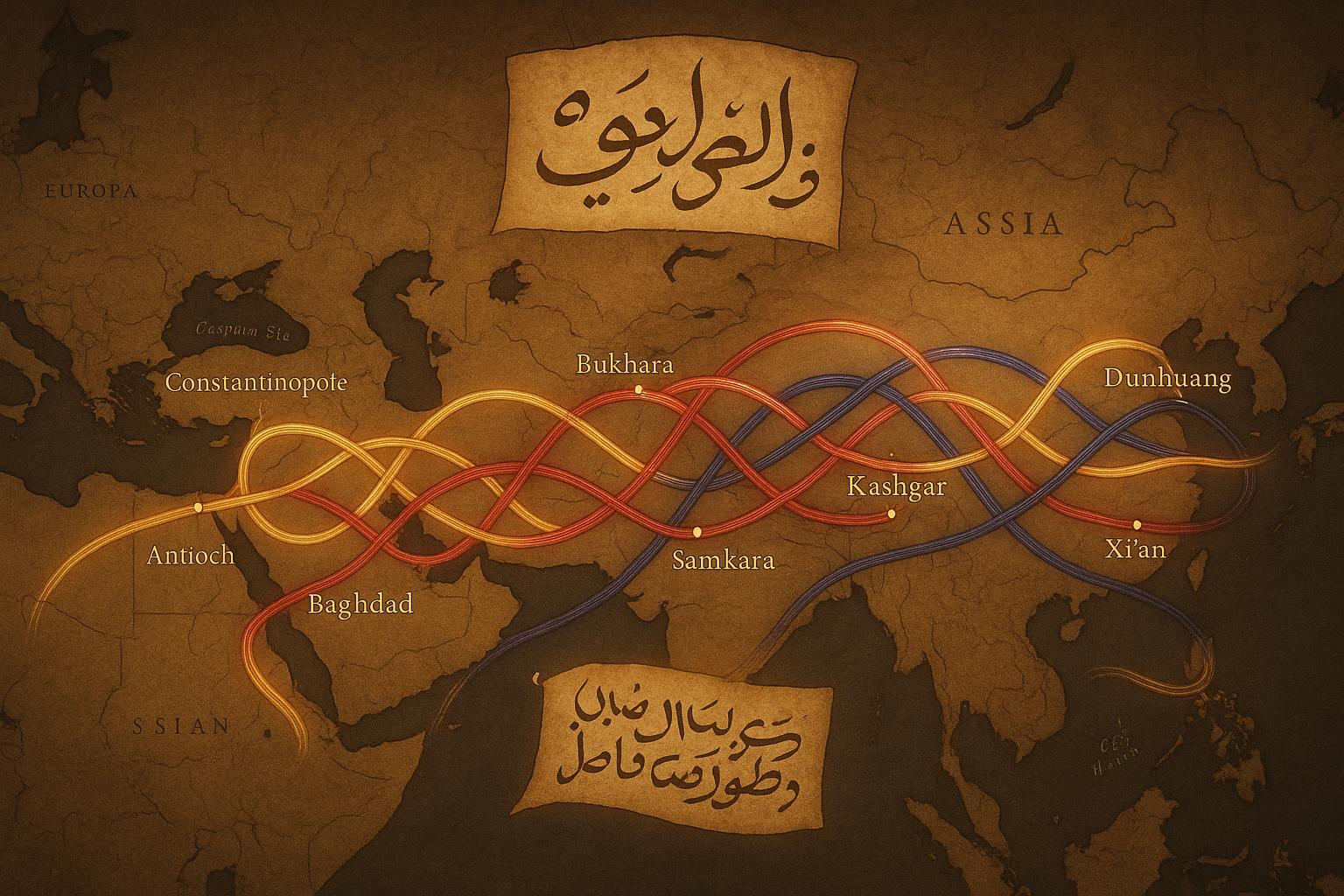Imagine the Silk Road. The word itself conjures images of endless deserts, lumbering camels laden with precious silks, and bustling caravan cities where fortunes were made and lost. We think of the empires this network connected—Han China, Parthian Persia, and the Roman West. But what was the sound of the Silk Road? When a merchant from Luoyang wanted to buy lapis lazuli from a trader whose home was in modern-day Afghanistan, what language did they speak? While Greek, Aramaic, Chinese, and dozens of other tongues were heard, for several crucial centuries, one language rose above the rest to become the true connective tissue of this vast network: Sogdian.
Long before English dominated global trade, the language of the Sogdians, an Iranian people from Central Asia, was the ‘whispering road’ that carried not just goods, but ideas, religions, and stories across a continent. This is the story of a lost lingua franca and the merchant people who carried it from the shores of the Mediterranean to the heart of China.
Who Were the Sogdians?
Unlike the Romans or the Han Chinese, the Sogdians never forged a great empire of their own. Their homeland, Sogdiana, was a collection of fertile river valleys and oasis city-states centered around the modern cities of Samarkand and Bukhara in Uzbekistan and Tajikistan. Strategically positioned, they were perpetually squeezed between the great powers of the day: the Persian empires to the west, nomadic steppe confederations to the north, and the powerful dynasties of China to the east.
Instead of conquering with armies, the Sogdians conquered with commerce. They were the ultimate middlemen, master merchants who understood that true power lay not in holding territory, but in controlling the flow of goods through it. From the 4th to the 8th centuries CE, they established a vast network of trading colonies that stretched thousands of miles. A Sogdian could leave his home in Samarkand and travel along a chain of friendly communities all the way to Chang’an, the glittering capital of Tang China, knowing he would find countrymen, family, and business partners at every major stop.
The Rise of a Merchant’s Tongue
A language becomes a lingua franca not through its elegance or complexity, but through its utility. And Sogdian was supremely useful. As Sogdian merchants came to dominate the overland trade routes, their language became the default language of the deal.
Picture a marketplace in Turfan, a vibrant oasis city in the Tarim Basin (modern Xinjiang, China). A Turkic nomad might be selling horses, a Chinese merchant offering silk, and an Indian trader selling medicinal herbs. The common language that could bridge these three individuals was very likely Sogdian. Contracts were written in it, negotiations were conducted in it, and ledgers were kept in it. The Sogdians’ economic dominance made their language indispensable.
Crucially, the spread of Sogdian was peaceful and organic. It wasn’t imposed by an emperor; it was adopted by choice for mutual benefit. To succeed on the Silk Road, you simply had to know some Sogdian.
A Script for Silk and Scripture
A language of trade needs a script, and the Sogdians had a remarkably effective one. Derived from the Aramaic alphabet—itself an ancient lingua franca of the Near East—the Sogdian script was an abjad, meaning it primarily represented consonants, leaving vowels to be inferred by the reader. It was written vertically, from top to bottom in columns running right to left, a distinctive feature that would have a massive impact.
This flexible script wasn’t just for business. The Sogdians were conduits for culture as much as for commerce. As they traveled, they adopted and transmitted new faiths. The Sogdian script was used to translate and transcribe texts for a remarkable variety of religions that flourished along the Silk Road:
- Buddhism: Many Buddhist sutras were translated from Sanskrit or Chinese into Sogdian, helping the religion spread into Central Asia and China.
- Manichaeism: For this Persian Gnostic religion, Sogdian was a major liturgical and literary language.
- Nestorian Christianity: Communities of Sogdian Christians also used their own language and script to copy out religious texts.
The greatest legacy of the Sogdian script, however, is its children. When the powerful Uyghur Khaganate rose, they adopted the Sogdian script to write their own Turkic language. This Old Uyghur script was later adopted by the Mongols under Genghis Khan, becoming the basis for the beautiful, vertically written traditional Mongolian script still used today. In the 17th century, the Manchus adapted the Mongolian script to create their own, meaning the writing system of China’s final imperial dynasty was a direct descendant of the one used by Sogdian merchants a thousand years earlier.
Echoes in the Archives: The Sogdian Ancient Letters
For a long time, our knowledge of the Sogdians was filtered through the accounts of others. But in 1907, the explorer Aurel Stein made a stunning discovery in the ruins of a watchtower near Dunhuang, a gateway to China on the Silk Road. He found a forgotten mailbag containing a bundle of paper documents. These were the “Ancient Letters,” the oldest significant texts written in Sogdian, dating to the early 4th century CE.
These letters offer an unparalleled, intimate glimpse into the lives of these merchants. They contain business instructions and reports on market conditions, but they also contain deeply personal stories. One of the most famous letters is from a woman named Miwnay, abandoned in Dunhuang by her merchant husband, writing a desperate plea to him and her mother for help. “I would rather be a dog’s or a pig’s wife than yours!” she laments, her voice echoing across 1,700 years of history, reminding us that these were real people with real tragedies, not just abstract figures on a trade route.
The Slow Fade: Why Did the Whispers Cease?
By the 9th century, the Sogdian language began its decline. There was no single event, but a confluence of factors. The Arab conquests of Central Asia in the 8th century introduced a new language of power, administration, and faith: Arabic. At the same time, a new form of Persian (Farsi) emerged as a dominant cultural and literary language in the region.
In China, the catastrophic An Lushan Rebellion (755-763 CE), which was led by a general of part-Sogdian descent, soured attitudes towards foreigners. The once-welcoming Tang Dynasty grew suspicious, and the Sogdian communities there lost their privileged position and began to assimilate.
Over time, the Sogdians themselves were absorbed into other emerging cultures. They assimilated into the Persian-speaking Tajik and Turkic-speaking Uzbek peoples, who became the dominant groups in their old homeland. The Silk Road itself changed, with sea routes becoming more important and political instability disrupting overland travel. The world no longer needed a Sogdian lingua franca.
A Final Whisper
The Sogdian language vanished from the world’s stage, but it never died out completely. In a remote, isolated valley of Tajikistan’s Yaghnob River, a small community of a few thousand people still speaks Yaghnobi, the sole direct descendant of the once-mighty Sogdian language. It is the final, living whisper of the language that once bound together the ancient world.
The story of Sogdian is a powerful reminder that the most influential languages are not always those backed by the largest armies. Sometimes, they are the languages of the traveler, the merchant, and the missionary—the quiet, practical tongues that build bridges between civilizations, one conversation, one contract, and one camel caravan at a time.








